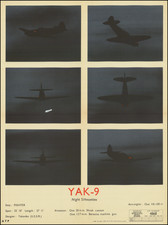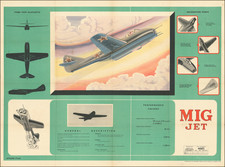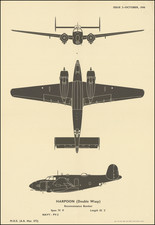Early Cold War Soviet-Built B-29
This poster is part of a series created by the British government to help identify aircraft amid emerging post-World War II tensions between capitalist and communist powers. Printed in London by Fosh & Cross Ltd., it features the "Russian Built B-29," or Tupolev Tu-4, a reverse-engineered version of the American B-29 bomber. The poster, published in May 1948, includes three silhouettes of the Tupolev B-29 and details of its operational duty as a bomber and its 141-foot wingspan. The publication date is significant as it was shortly after the Tupolev's existence came to light in 1947, when military observers noticed a Soviet bomber resembling the U.S. B-29. This poster likely serves as a response to that revelation.
The Tupolev Tu-4
As the Second World War drew to a close, the USSR recognized its weakness in airpower when compared to the West. The Soviets lacked a long-range bomber that could target the United States so there was great desire to develop a craft similar to the B-29. Throughout the war, the U.S. did not supply any B-29s to the Soviets under lend-lease. However, in 1944 several B-29s on their way back from the Pacific were forced to make emergency landings in the USSR. At the time, Russia was officially neutral in the Pacific War, so they seized the bombers and attempted to reverse-engineer them. This process proved harder than expected for two main reasons. First, the United States produced its military equipment with the imperial system while the Soviets used the metric. This meant that many of the tools, parts, and even the aluminum armor of the plane could not be produced domestically until they designed a model with metric measurements. In addition, the USSR lacked some production capabilities for certain alloys and materials integral to the production of the Tuplov. New industrial operations would have to be developed to ensure the Soviets could build their new plane.
As soon as the Tupolev Tu-4 entered official service in 1949, the aerial capabilities of the Soviet Union expanded exponentially. The USSR now had a bomber that could rival the range and accuracy of the B-29. This was absolutely a boon for the Soviet Air Force, but technological developments would make the Tupolev a short-lived success. With the rise of jet aviation in the mid to late 1950s, the Tupolev soon became obsolete. Its design was partially used to inform future Soviet jet bombers, but the plane was mostly phased out of active service by the end of the decade. Some Tupolev Tu-4s continued to serve in a secondary capacity as reconnaissance planes, but by the late 1960s the Soviet military had phased out the plane with its seemingly antiquated technology.
The development of the Tupolev Tu-4 foreshadowed the military build-up and arms race that would consume the USSR and the United States throughout the Cold War. Although somewhat limited in its service, the Tupolev would inform military policy in both the Soviet Union and the United States. The desire to protect national secrets in technology while also developing more powerful weapons lies at the heart of the Cold War. This poster foreshadows the coming conflict in a deceptively simple way.










![[ Bombing Kansas City, Missouri ] USAF Target Complex Chart Series 100 Restricted](https://storage.googleapis.com/raremaps/img/small/97394.jpg)

![(Cold War) P2V Neptune [with] PBM Mariner](https://storage.googleapis.com/raremaps/img/small/97127.jpg)

![(Cold War - Czechoslovakia) Sily Miru Zvite [The Forces of Peace Will Win]](https://storage.googleapis.com/raremaps/img/small/97875.jpg)